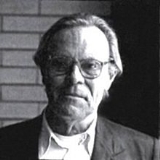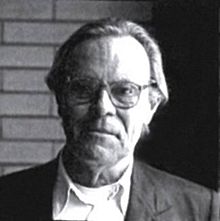
Carlo Aymonino
Encyclopedia

Italy
Italy , officially the Italian Republic languages]] under the European Charter for Regional or Minority Languages. In each of these, Italy's official name is as follows:;;;;;;;;), is a unitary parliamentary republic in South-Central Europe. To the north it borders France, Switzerland, Austria and...
architect and urban planner best known for the Gallaretese housing complex in Milan
Milan
Milan is the second-largest city in Italy and the capital city of the region of Lombardy and of the province of Milan. The city proper has a population of about 1.3 million, while its urban area, roughly coinciding with its administrative province and the bordering Province of Monza and Brianza ,...
.
Early life
Born in RomeRome
Rome is the capital of Italy and the country's largest and most populated city and comune, with over 2.7 million residents in . The city is located in the central-western portion of the Italian Peninsula, on the Tiber River within the Lazio region of Italy.Rome's history spans two and a half...
, he studied at the University of Rome
University of Rome La Sapienza
The Sapienza University of Rome, officially Sapienza – Università di Roma, formerly known as Università degli studi di Roma "La Sapienza", is a coeducational, autonomous state university in Rome, Italy...
, obtaining his degree in 1950. In the same years, he also got trained by Marcello Piacentini
Marcello Piacentini
Marcello Piacentini was an Italian architect and urban theorist.-Biography:Born in Rome, he was the son of architect Pio Piacentini...
.
Architectural works
The year after his graduation, he opened his architectural practice in RomeRome
Rome is the capital of Italy and the country's largest and most populated city and comune, with over 2.7 million residents in . The city is located in the central-western portion of the Italian Peninsula, on the Tiber River within the Lazio region of Italy.Rome's history spans two and a half...
.
Between 1949 and 1954, with the very famous Mario Ridolfi and Ludovico Quaroni he had his first real professional experience, building the INA-Casa housing complex. This was located in Rome, on Via Tiburtina, and is a remarkable example of Italian neo-realism
Italian neorealism
Italian neorealism is a style of film characterized by stories set amongst the poor and working class, filmed on location, frequently using nonprofessional actors...
.
Through this architectural experience, he acquired the practical skills which will be visible in later housing projects. Among the letter, remarkable were the 1955 'Spine Bianche' complex, located in the city of Matera, and the 1957 'Tratturo dei Preti' housing project, in the city of Foggia.
From 1967 to 1970, Aymonino, as part of Studio AYDE, collaborated with Aldo Rossi
Aldo Rossi
Aldo Rossi was an Italian architect and designer who accomplished the unusual feat of achieving international recognition in four distinct areas: theory, drawing, architecture and product design.-Early life:...
on the design of the Monte Amiata
Monte Amiata Housing
Monte Amiata Housing is a residential complex in the Gallaratese district of Milan, Italy, designed by architects Carlo Aymonino and Aldo Rossi in the late 1960s. It is sometimes referred to as the "Red Dinosaur" in reference both to the reddish color of the buildings and the oddity of their design...
housing blocks in the Gallaratese
Gallaratese
Gallaratese is a district of Milan, Italy, part of the Zone 8 administrative division of the city. It is located about 7 km north-west of the city centre...
development outside Milan.
Writer and Editor
Starting in 1954, Aymonino also worked as editor of the magazine Il contemporaneo.Between 1957 and 1965 he also wrote for Casabella
Casabella
Casabella is an Italian architectural and product design magazine with a focus on modern, radical design. It includes interviews with the world's most prominent architects....
, participating to the late 1950s strong, vivid cultural and architectural debates.
In 1973, Aymonino published L'Abitazione Razionale: Atti de Congressi CIAM 1929-30, an analysis of social housing. It catalogued and analyzed apartment plans from modernist developments in European and American cities, as well as older courtyard houses and linear houses. It was one of the early examples of a typological
Typology (urban planning and architecture)
Typology is the taxonomic classification of characteristics commonly found in buildings and urban places, according to their association with different categories, such as intensity of development , degrees of formality, and school of thought...
approach to architecture and urbanism, which are central to the neo-Rationalist and New Urbanist movements. The book also included reprints of papers on social housing from the Congrès International d'Architecture Moderne
Congrès International d'Architecture Moderne
The Congrès internationaux d'architecture moderne – CIAM was an organization founded in 1928 and disbanded in 1959, responsible for a series of events and congresses arranged around the world by the most prominent architects of the time, with the objective of spreading the principles of the Modern...
(CIAM) conferences in Frankfurt in 1929 (papers by Siegfried Giedion, Ernst May
Ernst May
Ernst May was a German architect and city planner.May successfully applied urban design techniques to the city of Frankfurt am Main during Germany's Weimar period, and in 1930 less successfully exported those ideas to Soviet Union cities, newly created under Stalinist rule...
, Walter Gropius
Walter Gropius
Walter Adolph Georg Gropius was a German architect and founder of the Bauhaus School who, along with Ludwig Mies van der Rohe and Le Corbusier, is widely regarded as one of the pioneering masters of modern architecture....
, Le Corbusier
Le Corbusier
Charles-Édouard Jeanneret, better known as Le Corbusier , was a Swiss-born French architect, designer, urbanist, writer and painter, famous for being one of the pioneers of what now is called modern architecture. He was born in Switzerland and became a French citizen in 1930...
, Victor Bourgeois
Victor Bourgeois
Victor Bourgeois was a Belgian architect and urban planner, considered the greatest Belgian modernist architect....
), and in Brussels in 1930 (Giedon, Böhm and Kaufmann, Gropius, Richard Neutra
Richard Neutra
Richard Joseph Neutra is considered one of modernism's most important architects.- Biography :Neutra was born in Leopoldstadt, the 2nd district of Vienna, Austria Hungary, on April 8, 1892. He was born into both-Jewish wealthy family...
, and Tiege).
Town planner
In 1957 Carlo Aymonino became a founder as well as a member of the Società di Architettura e Urbanistica - S.A.U. (Town Planning & Architecture Society).Concerning the town planning activity, Aymonino developed the idea of the Directional Centre as a tool capable of linking a city to its surroundings. This appeared applicable in particular to recognizable urban typologies.
Aymonino put into practice such concepts and theories in the 1962 competition proposals for the city centres of Turin and Bologna.

